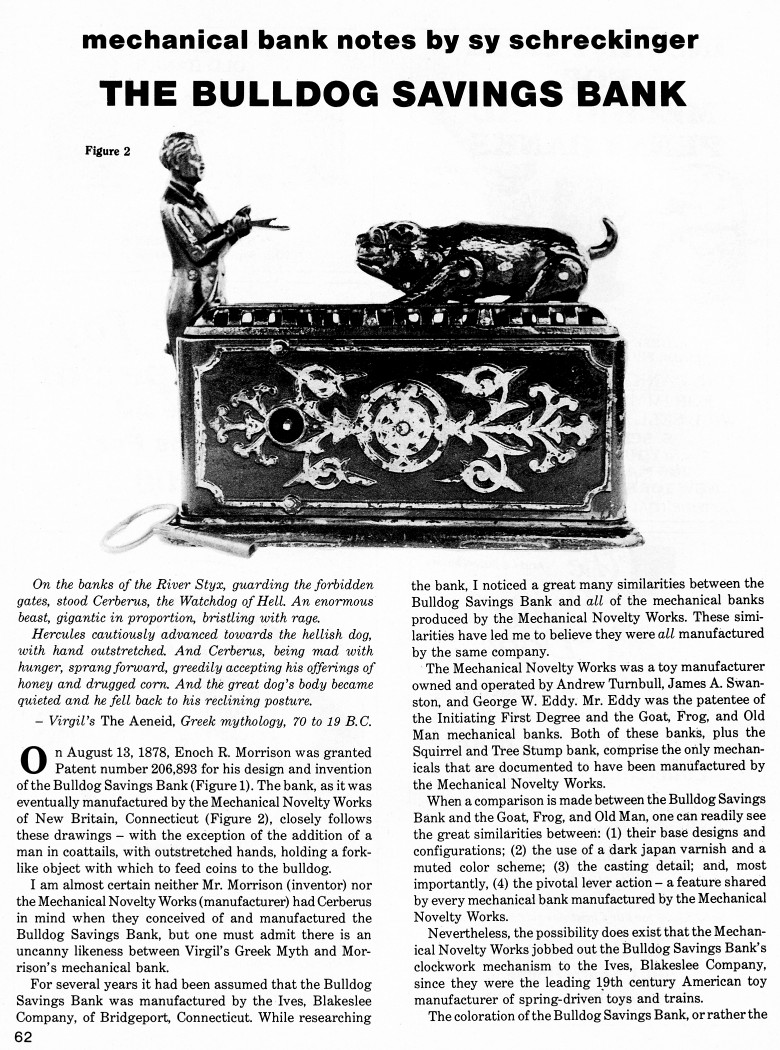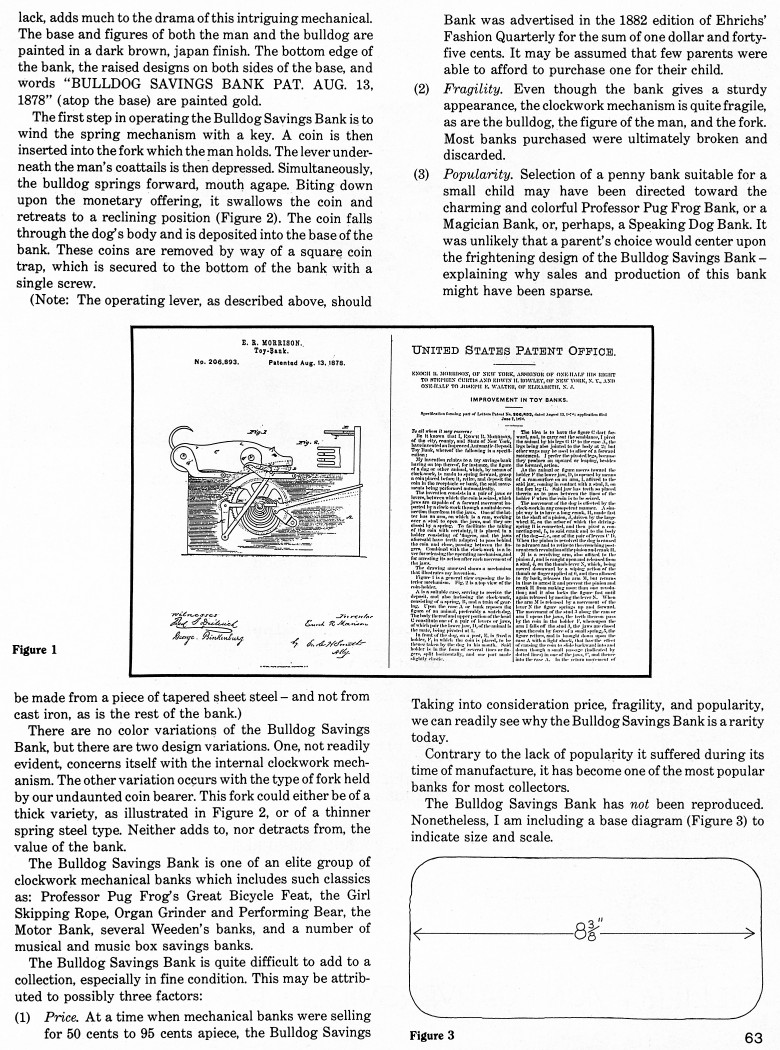|
The
Bulldog Savings Bank
by Sy Schreckinger – ANTIQUE TOY WORLD Magazine – November,
1984
On the banks of the River Styx, guarding the
forbidden gates, stood Cerberus, the Watchdog of Hell. An enormous beast,
gigantic in proportion, bristling with rage.
Hercules cautiously advanced towards the hellish dog, with hand
outstretched. And Cerberus, being mad with hunger, sprang forward,
greedily accepting his offerings of honey and drugged corn. And the great
dog's body became quieted and he fell back to his reclining posture.
– Virgil's The Aeneid, Greek mythology, 70 to 19 B.C.
On August 13, 1878, Enoch R. Morrison was granted Patent number
206,893 for his design and invention of the Bulldog Savings Bank (Figure
1). The bank, as it was eventually manufactured by the Mechanical Novelty
Works of New Britain, Connecticut (Figure 2), closely follows these
drawings – with the exception of the addition of a man in coattails, with
outstretched hands, holding a forklike object with which to feed coins to
the bulldog.
I am almost certain neither Mr. Morrison (inventor) nor the
Mechanical Novelty Works (manufacturer) had Cerberus in mind when they
conceived of and manufactured the Bulldog Savings Bank, but one must admit
there is an uncanny likeness between Virgil's Greek Myth and Morrison's
mechanical bank.
For several years it had been assumed that the Bulldog Savings Bank
was manufactured by the Ives, Blakeslee Company, of Bridgeport,
Connecticut. While researching the bank, I noticed a great many
similarities between the Bulldog Savings Bank and all of the mechanical
banks produced by the Mechanical Novelty Works. These similarities have
led me to believe they were all manufactured by the same company.
The Mechanical Novelty Works was a toy manufacturer owned and
operated by Andrew Turnbull, James A. Swanston, and George W. Eddy. Mr.
Eddy was the patentee of the Initiating First Degree and the Goat, Frog,
and Old Man mechanical banks. Both of these banks, plus the Squirrel and
Tree Stump bank, comprise the only mechanicals that are documented to have
been manufactured by the Mechanical Novelty Works.
When a comparison is made between the Bulldog Savings Bank and the
Goat, Frog, and Old Man, one can readily see the great similarities
between: (1) their base designs and configurations; (2) the use of a dark
japan varnish and a muted color scheme; (3) the casting detail; and, most
importantly, (4) the pivotal lever action – a feature shared by every
mechanical bank manufactured by the Mechanical Novelty Works.
Nevertheless, the possibility does exist that the Mechanical Novelty
Works jobbed out the Bulldog Savings Bank's clockwork mechanism to the
Ives, Blakeslee Company, since they were the leading 19th century American
toy manufacturer of spring-driven toys and trains.
The coloration of the Bulldog Savings Bank, or rather the lack, adds much
to the drama of this intriguing mechanical. The base and figures of both
the man and the bulldog are painted in a dark brown, japan finish. The
bottom edge of the bank, the raised designs on both sides of the base, and
words "BULLDOG SAVINGS BANK PAT. AUG. 13, 1878" (atop the base) are
painted gold.
The first step in operating the Bulldog Savings Bank is to wind the
spring mechanism with a key. A coin is then inserted into the fork which
the man holds. The lever underneath the man's coattails is then depressed.
Simultaneously, the bulldog springs forward, mouth agape. Biting down upon
the monetary offering, it swallows the coin and retreats to a reclining
position (Figure 2). The coin falls through the dog's body and is
deposited into the base of the bank. These coins are removed by way of a
square coin trap, which is secured to the bottom of the bank with a single
screw.
(Note: The operating lever, as described above, should be made from a
piece of tapered sheet steel – and not from cast iron, as is the rest of
the bank.)
There are no color variations of the Bulldog Savings Bank, but there
are two design variations. One, not readily evident, concerns itself with
the internal clockwork mechanism. The other variation occurs with the type
of fork held by our undaunted coin bearer. This fork could either be of a
thick variety, as illustrated in Figure 2, or of a thinner spring steel
type. Neither adds to, nor detracts from, the value of the bank.
The Bulldog Savings Bank is one of an elite group of clockwork
mechanical banks which includes such classics as: Professor Pug Frog's
Great Bicycle Feat, the Girl Skipping Rope, Organ Grinder and Performing
Bear, the Motor Bank, several Weeden's banks, and a number of musical and
music box savings banks.
The Bulldog Savings Bank is quite difficult to add to a collection,
especially in fine condition. This may be attributed to possibly three
factors:
(1) Price. At a time when mechanical banks were selling for 50 cents to 95
cents apiece, the Bulldog Savings Bank was advertised in the 1882 edition
of Ehrichs' Fashion Quarterly for the sum of one dollar and forty-five
cents. It may be assumed that few parents were able to afford to purchase
one for their child.
(2) Fragility. Even though the bank gives a sturdy appearance, the
clockwork mechanism is quite fragile, as are the bulldog, the figure of
the man, and the fork. Most banks purchased were ultimately broken and
discarded.
(3) Popularity. Selection of a penny bank suitable for a small child may
have been directed toward the charming and colorful Professor Pug Frog
Bank, or a Magician Bank, or, perhaps, a Speaking Dog Bank. It was
unlikely that a parent's choice would center upon the frightening design
of the Bulldog Savings Bank – explaining why sales and production of this
bank might have been sparse.
Taking into consideration price, fragility, and popularity, we can
readily see why the Bulldog Savings Bank is a rarity today.
Contrary to the lack of popularity it suffered during its time of
manufacture, it has become one of the most popular banks for most
collectors.
The Bulldog Savings Bank has not been reproduced. Nonetheless, I am
including a base diagram (Figure 3) to indicate size and scale.
|

